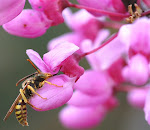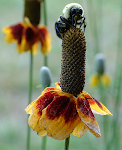
We have larvae! So exciting to check the hives on Sunday and to discover I am the proud parent of hundreds of little embryonic bees. My queens are doing a great job - both Elizabeth I and Kathryn the Great are filling up combs.
In the picture above (by Scott Camazine/ Science Photo Library) you can see little curled up larval baby bees in their cells. Next to them are "capped brood" cells colored sort of tan. The latter are in the final metamorphosis phase before hatching as full grown, fuzzy striped bees.
Bees go through 4 phases: egg, larva, pupa and adult. Development from egg to new worker typically takes two to three weeks. Great book on this: Tales From the Hive.

Egg
The eggs are described as having an appearance similar to sausage-shaped poppy seeds - except that they are white and standing on one end. They are really really hard to see. One of my beekeeping teachers said "don't worry about it - if you see larvae next week you'll know everything's ok." He was right. Hatching takes place three days after egg laying.
Larva
The larval stage lasts eight to nine days. Upon hatching, the larva resembles a small, white, curved, segmented worm lacking legs and eyes. For the first two days, all larvae are fed a diet of royal jelly. Beginning the third day, worker larvae are fed honey, pollen and water, while the larvae destined to become queens continue to receive royal jelly throughout their larval lives. Regardless of whether the larva is male or female, it molts five times during its larval stage.
| |
Care of the larvae is constant. Each larva receives an estimated 10,000 meals during this stage. The nurse bees do all this feeding - they get water from the foraging worker bees and pollen that was stored in the comb around the brood cells. The bees are all about raising babies.
Larval stage durations vary:
5.5 days for queens (fertile females),
6 days for workers (sterile females), and
6.5 days for drones (fertile males) (Jean-Prost, 1994).
Pupa
The pupal stage is a stage of massive reorganization of tissues. Organs undergo a complete reorganization, while body changes from the wormlike larval body shape to the adult body shape with three distinct body regions. Pupation periods vary: queens require up to 7.5 days, drones require14.5 days, while workers require 12 days.
I can't wait to see a bee hatch!
 Queen and worker pupae. Note the larger size of the queen pupa. Photo by Zach Huang. Queen and worker pupae. Note the larger size of the queen pupa. Photo by Zach Huang. |




